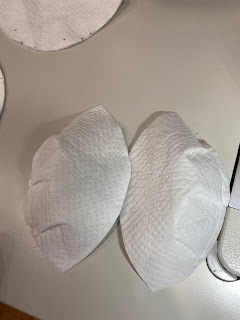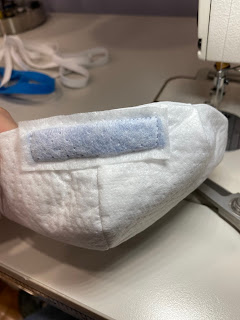Apply Elastic with a serger
Ashworth Classic Patterns has a new pattern coming!
It's a cowl neck knit dress and currently in the testing phase.
This dress features a bell sleeve that gathers into a cuff. You will leave 1" of the sleeve edge open for gathering when you sew the side seams and under arm (the easiest way to do it). You can use this method to gather your sleeve to ready it to be inserted into the cuff.
Let me know in the comments your favorite method of gathering knits!
Amy
Monday, July 6, 2020
Friday, May 29, 2020
Saturday, May 23, 2020
Saturday, May 2, 2020
How to extrapolate grade rules from a basic block, sloper, or pattern
This video explains the process the process of pulling grading data from a graded nest (whether a block, sloper, or pattern) and how to use it to develop a coordinate grade rule table. Designers and pattern makers need grading data to determine how a pattern will grow or shrink between sizes, and standard rules have been developed for the grading of certain common points on a garment. The garment used in this example is a pant block. Standard grade rules that a designer uses in his or her commercial patterns should be purchased and using another designer's grade rules is unethical and illegal. Academic slopers, blocks, and grading books have been published to meet this need. Standard grade rules are a starting point for any designer, and should be subject to fit testing based on your design, choice of fabric, target clientele, and here: https://www.printablepaper.net/previe...
If you are a designer looking for patternmaking services, including grading and sample making, please send an inquiry to amy@acashworthco.com , subject line "Production Patternmaking"
Tuesday, March 31, 2020
DIY Protective Face Mask Pattern (NOT COTTON)
You all know the need, and what to do. With the current guidelines, we all should be wearing masks in public. This mask pattern is what I believe is the most protective design, and uses fabrics that are among the most protective, according to Filti Mask Test Results.
How is this pattern different? This face mask is designed to cup the face with a better seal than any other pattern I've seen to date. We've added some special details that we believe will make the design protect better. It is shaped like the N95, and it's been tested for fit.
With all the controversy about cotton masks, you might be thinking, how can we make a mask that is safer? Well, this pattern is the answer to that. We've found a source for good filtration fabric, using patent pending Nanofiber technology, which, according to the manufacturer, is highly efficient on sub-micron particles. And the best part? It's hand washable! * Please see note in comments below regarding the drop in efficiency. As of April 1, we had information from Filti that the fabric was hand washable with soap and water (for a few times, at least). As with everything regarding this virus, new information is coming to light daily, and I am currently checking into any new developments or testing regarding this. Filti fabric is washable, but it is not guaranteed that washing will eliminate the COVID-19 virus particles from the mask. Because of the threat of the virus remaining after washing, Filti has recommended that you use the CDC decontamination methods listed HERE . I have verified that Filti recommends heating to decontaminate as follows:
You may heat the material to 150F for 30 minutes and the product will still have its original efficiency capabilities!
As with everything regarding this virus, we are getting new information every day, and the information provided here is updated as soon as I become aware. Please do your own research and make the best choice for yourself.
Download our pattern below to find out where to get this special fabric!
You may heat the material to 150F for 30 minutes and the product will still have its original efficiency capabilities!
As with everything regarding this virus, we are getting new information every day, and the information provided here is updated as soon as I become aware. Please do your own research and make the best choice for yourself.
Some masks similar to our design have been tested, but we have not conducted any specific tests on our masks and we make no claims regarding their protective ability.
Download our pattern below to find out where to get this special fabric!
 Download FREE Pattern NOW
Download FREE Pattern NOW To date, our tailor shop has made dozens of these masks. If you would like to sew along with us, stay tuned, and I'll go over all the steps below.
Just to reinforce all the warnings in the pattern instructions:
- Don't use pins
- Don't use hot glue on the filter fabric
- Use a #9 needle.
At this time, you will also cut out your lining. In my experience, the filti fabric can be irritating to the skin, so I strongly recommend a lining. I used a plain broadcloth, which is a polyester-cotton blend.

Next, we are going to pinch the pleats together, with the folds going downward, and baste them down along the seamline to hold them in place.
 Do the same thing to the other half of the mask, making sure you have marked the TOP of the mask, and making sure you have a right and a left.
Do the same thing to the other half of the mask, making sure you have marked the TOP of the mask, and making sure you have a right and a left.
Do this for all your layers, and the lining, too.
Now, sew together the halves, right sides together, down the center (the unpleated edge). Do this for every layer, and the lining, too. Notch that curve with your scissors. Then turn the halves out,and finger press the seam.
Now you will place the formed mask and lining right sides together, and sew around the perimeter, leaving a gap at the top, to turn it.
Now, let's turn that mask right side out through the gap. That's really hard to show in a picture.
Now we just smooth it out, and sew up that gap at the top.
Now on to the nose piece. You will have taken a 2" piece of wire, and hot glued it into a small swatch of felt, enclosing it on all sides.
Take a larger rectangle of the filter fabric, and center it over the wire-felt piece. Line the wire casing up with the top edge of the mask; the filter fabric topper can hang over the edge.
Sew through the filter fabric topping to encase the nose wire on all sides, while attaching it evenly to the top of the mask.
This is how it will look from the inside when you are done.
As you can see, we've left some excess all around that topping so that you don't have to worry too much about lining it up while sewing, and we will trim that excess off now.

Be careful as you trim the excess, don't nick your mask.
Next we will do the inside edge strip. The idea behind this is that it helps the mask seal to your face. It acts sort of like weather stripping. Remember - we aren't using pins. So hold it along the edge under your work, and topstitch along the edge, being careful to catch the felt strip underneath. This isn't a race ;)
Here's your finished edge strip from the inside.
Lastly, you attach the elastic at the areas that you marked from your pattern. You did mark those, right? I knew you would.
I like the two-step approach to securing the elastic.
First, set the elastic end toward the edge of the mask. Secure it down by running back and forth over it a few times.
Now, pass the elastic over the stitches, folding it over to the right. Stitch this down, encasing the raw edge of the elastic. Again, I run over it a few times to secure it well.
Attach the other end of the elastic to the opposite side, and repeat with the other elastic, on the lower markings.
Comment below with any comments or questions... download, share, and sew up as many as you can!
Blessings and safety to you all, as you help in the fight against COVID-19 by making these masks!
x
Amy
Subscribe to:
Posts (Atom)

























